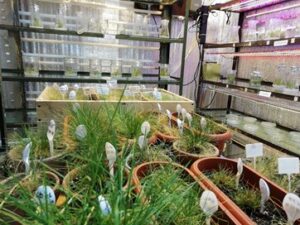


Spring has sprung! And to welcome the new season, Ukraine's Institute of Molecular Biology and Genetics (IMBG) took its social media followers on a stunning virtual tour of the Department of Cell Population Genetics laboratory.
The first stop: Deschampsia antarctica (or Antarctic hairgrass) - one of only two native flowering plants found in the Antarctic region (the other is Colobanthus - more about that plant later).
The first seeds of this amazing plant were brought to Ukraine by polar explorers from the Ukrainian Akademik Vernadsky Research Base more than a decade ago. The adult plants didn’t survive in laboratory conditions, but after a long and difficult process (only a few seeds out of thousands germinate), the department’s scientists succeeded in growing an “Antarctic bed of flowers” in Ukraine.
Today, almost the entire population of the Institute’s Deschampsia are plants that were reproduced by in vitro cloning (in a test tube). Small pieces of the bush are transferred to a special nutrient medium where it grows and sprouts. Its reproduction rate is 1:50.
Recently, the Institute’s scientists managed to develop a callus culture - a culture of undifferentiated plant cells similar to a stem cell of animals. All dicotyledonous plants have the ability to create a callus, but grasses (which include the Antarctic hairgrass) form them less often. IMBG biotechnologists have found the appropriate conditions that stimulate its cells to proliferate and form a callus tissue, which can exist in this form for a long time. Each of the callus cells can further regenerate a new plant.
Interestingly, there are different forms of hairgrass - with different numbers of chromosomes, different genetic characteristics - growing on the islands (Skua, Winter, Rasmussen, Darboux) near the Ukrainian Antarctic station.
"Our department has 22 genotypes of Deschampsia, which accumulate secondary metabolites in different quantities, those that cause resistance to ultraviolet light and have medicinal value," says the head of the Department of Cell Population Genetics Dr. Viktor Kunakh.
Top photo: Special phytolamps provide the necessary light spectrum for the plant growth
Photos by Viktoria Pyeshkova and Dr. Viktor Kunakh

Dr. Viktor Kunakh shows flasks with Antarctic hairgrass propagated by cloning

